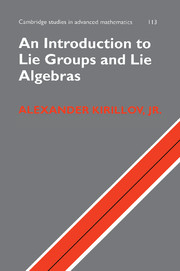Book contents
- Frontmatter
- Contents
- Preface
- 1 Introduction
- 2 Lie groups: basic definitions
- 3 Lie groups and Lie algebras
- 4 Representations of Lie groups and Lie algebras
- 5 Structure theory of Lie algebras
- 6 Complex semisimple Lie algebras
- 7 Root systems
- 8 Representations of semisimple Lie algebras
- Overview of the literature
- Appendix A Root systems and simple Lie algebras
- Appendix B Sample syllabus
- List of notation
- Bibliography
- Index
4 - Representations of Lie groups and Lie algebras
Published online by Cambridge University Press: 31 May 2010
- Frontmatter
- Contents
- Preface
- 1 Introduction
- 2 Lie groups: basic definitions
- 3 Lie groups and Lie algebras
- 4 Representations of Lie groups and Lie algebras
- 5 Structure theory of Lie algebras
- 6 Complex semisimple Lie algebras
- 7 Root systems
- 8 Representations of semisimple Lie algebras
- Overview of the literature
- Appendix A Root systems and simple Lie algebras
- Appendix B Sample syllabus
- List of notation
- Bibliography
- Index
Summary
In this section, we will discuss the representation theory of Lie groups and Lie algebras – as far as it can be discussed without using the structure theory of semisimple Lie algebras. Unless specified otherwise, all Lie groups, algebras, and representations are finite-dimensional, and all representations are complex. Lie groups and Lie algebras can be either real or complex; unless specified otherwise, all results are valid both for the real and complex case.
Basic definitions
Let us start by recalling the basic definitions.
Definition 4.1. A representation of a Lie group G is a vector space V together with a morphism ρ:G → GL(V).
A representation of a Lie algebra g is a vector space V together with a morphism ρ:g → gl(V).
A morphism between two representations V, W of the same group G is a linear map f:V → W which commutes with the action of G:f ρ(g) = ρ(g)f. In a similar way one defines a morphism of representations of a Lie algebra. The space of all G-morphisms (respectively, g-morphisms) between V and W will be denoted by HomG(V, W) (respectively, Homg(V, W)).
Remark 4.2. Morphisms between representations are also frequently called intertwining operators because they “intertwine” action of G in V and W.
The notion of a representation is completely parallel to the notion of module over an associative ring or algebra; the difference of terminology is due to historical reasons.
- Type
- Chapter
- Information
- An Introduction to Lie Groups and Lie Algebras , pp. 52 - 83Publisher: Cambridge University PressPrint publication year: 2008

